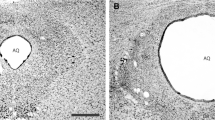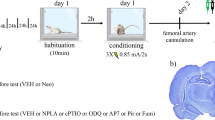Abstract
Rationale
The midbrain periaqueductal gray (PAG) is part of the brain system involved in active defense reactions to threatening stimuli. Glutamate N-methyl-d-aspartate (NMDA) receptor activation within the dorsal column of the PAG (dPAG) leads to autonomic and behavioral responses characterized as the fear reaction. Nitric oxide (NO) has been proposed to be a mediator of the aversive action of glutamate, since the activation of NMDA receptors in the brain increases NO synthesis.
Objectives
We investigated the effects of intra-dPAG infusions of NMDA on defensive behaviors in mice pretreated with a neuronal nitric oxide synthase (nNOS) inhibitor [Nω-propyl-l-arginine (NPLA)], in the same midbrain site, during a confrontation with a predator in the rat exposure test (RET).
Materials and methods
Male Swiss mice received intra-dPAG injections of NPLA (0.1 or 0.4 nmol/0.1 μl), and 10 min later, they were infused with NMDA (0.04 nmol/0.1 μl) into the dPAG. After 10 min, each mouse was placed in the RET.
Results
NMDA treatment enhanced avoidance behavior from the predator and markedly increased freezing behavior. These proaversive effects of NMDA were prevented by prior injection of NPLA. Furthermore, defensive behaviors (e.g., avoidance, risk assessment, freezing) were consistently reduced by the highest dose of NPLA alone, suggesting an intrinsic effect of nitric oxide on defensive behavior in mice exposed to the RET.
Conclusions
These findings suggest a potential role of glutamate NMDA receptors and NO in the dPAG in the regulation of defensive behaviors in mice during a confrontation with a predator in the RET.




Similar content being viewed by others
References
Aguiar DC, De Lucca AC, Guimarães FS (2004) Role of nitric oxide on chemically-induced defensive reactions in the dorsolateral periaqueductal grey. Eur Neuropsychopharmacol 14(suppl. 3):S305
Bandler R, Carrive P (1988) Integrated defense reaction elicited by excitatory amino acid in the midbrain periaqueductal gray region of the unrestrained cat. Brain Res 439:95–106
Bandler R, Depaulis A (1991) Midbrain periaqueductal gray control of defensive behavior in the cat and the rat. In: Bandler R, Depaulis A (eds) The midbrain periaqueductal gray matter: functional, anatomical and neurochemical organization. Plenum, New York, pp 175–197
Bandler R, Shipley MT (1994) Columnar organization in the midbrain periaqueductal gray: modulates for emotional expression? Trends Neurosci 17:379–389
Bandler R, Carrive P, Zhang SP (1991) Integration of somatic autonomic reactions within the midbrain periaqueductal gray: viscerotopic, somatotopic and functional organization. Prog Brain Res 87:269–305
Behbehani MM (1995) Functional characteristics of the midbrain periaqueductal gray. Progress Neurobiol 46:575–605
Beijamini V, Guimarães FS (2006) c-Fos expression increase in NADPH-diaphorase positive neurons after exposure to a live cat. Behav Brain Res 170:52–61
Bergink V, Van Megen HJGM, Westenberg HGM (2004) Glutamate and anxiety. Eur Neuropharmacol 14:175–183
Bertoglio LJ, Zangrossi H Jr (2006) Involvement of dorsolateral periaqueductal gray N-methyl-d-aspartic acid glutamate receptors in the regulation of risk assessment and inhibitory avoidance behaviors in the rat elevated T-maze. Behav Pharmacol 17:589–596
Blanchard RJ, Hebert MA, Ferrari PF, Palanza P, Figueira R, Blanchard DC, Parmigiani S (1998) Defensive behaviors in wild and laboratory (Swiss) mice: the mouse defense test battery. Physiol Behav 65(2):201–209
Calvo-Torrent A, Brain PF, Martinez M (1999) Effect of predatory stress on sucrose intake and behavior on the plus-maze in male mice. Physiol Behav 67:189–196
Carobrez AP, Teixeira KV, Graeff FG (2001) Modulation of defensive behavior by periaqueductal gray NMDA/glycine-B receptor. Neurosci Biobehav Rev 25:697–709
Carrive P (1993) The periaqueductal gray and defensive behavior: functional significance and neuronal organization. Behav Brain Res 58:27–47
Carvalho-Netto EF, Markham C, Blanchard DC, Nunes-De-Souza RL, Blanchard RJ (2006) Physical environment modulates the behavioral responses induced by chemical stimulation of dorsal periaqueductal gray in mice. Pharmacol Biochem Behav 85:140–147
Carvalho-Netto EF, Litvin Y, Nunes-De-Souza RL, Blanchard DC, Blanchard RJ (2007) Effects of intra-PAG infusion of ovine CRF on defensive behaviors in Swiss-Webster mice. Behav Brain Res 176:222–229
De Oliveira RW, Guimarães FS (1999) Anxiolytic effect of methylene blue microinjected into the dorsal periaqueductal gray. Braz J Med Biol Res 32:1529–1532
De Oliveira RW, Del Bel EA, Guimarães FS (2001) Effects of excitatory amino acids and nitric oxide on flight behavior elicited from the dorsolateral periaqueductal gray. Neurosci Biobehav Rev 25:679–685
Esplugues J (2002) NO as a signalling molecule in the nervous system. Br J Pharmacol. 135:1079–1095
Faria MS, Muscara MN, Moreno H Jr, Dias SA, Oliveira B, Graeff FG, De Nucci G (1997) Acute inhibition of nitric oxide synthesis induces anxiolysis in the plus maze test. Eur J Pharmacol 323:37–343
Forestiero D, Manfrim CM, Guimarães FS, De Oliveira RM (2006) Anxiolytic-like effects induced by nitric oxide synthase inhibitors microinjected into the medial amygdala of rats. Psychopharmacology (Berl) 184:166–172
Garthwaite J (1991) Glutamate, nitric oxide and cell-cell signalling in the nervous system. Trends Neurosci 14:60–67
Garthwaite J, Garthwaite G, Palmer RM, Moncada S (1989) NMDA receptor activation induces nitric oxide synthesis from arginine in rat brain slices. Eur J Pharmacol 172:413–416
Graeff FG (1981) Minor tranquilizers and brain defense system. Braz J Med Biol Res 14:239–265
Graeff FG (1994) Neuroanatomy and neurotransmitter regulation of defensive behaviors and related emotions in mammals. Braz J Med Biol Res 27(4):811–829
Graeff FG (2004) Serotonin, the periaqueductal gray and panic. Neurosci Biobehav Rev 28:239–259
Guimarães FS, Carobrez AP, De Aguiar JC, Graeff FG (1991) Anxiolytic effect in the elevated plus maze of NMDA receptor antagonist AP 7 microinjected into the dorsal periaqueductal gray. Psychopharmacology (Berl) 103:91–94
Guimarães FS, De Aguiar JC, Del-Bel EA, Ballejo G (1994) Anxiolytic effect of NO synthase inhibitors microinjected into the dorsal central grey. Neuro Report 5:123–126
Guimarães FS, Beijamini V, Moreira FA, Aguiar DC, De Luca ACB (2005) Role of nitric oxide on brain regions related to defensive reactions. Neurosci Biobehav Rev 29:1313–1322
Lin HC, Kang BH, Wan FJ, Huang ST, Tseng CJ (2000) Reciprocal regulation of nitric oxide and glutamate in the nucleus tractus solitarii of rats. Eur J Pharmacol 407:83–89
Litvin Y, Pentkowski NS, Blanchard DC, Blanchard RJ (2007) CRF type 1 receptors in the dorsal periaqueductal gray modulate anxiety-induced defensive behaviors. Horm Behav 52:244–251
Litvin Y, Pentkowski NS, Pobbe RL, Blanchard DC, Blanchard RJ (2008) Unconditioned models of fear and anxiety. In: Blanchard DC, Blanchard RJ, Griebel G, Nutt D (eds) Handbook of anxiety and fear. Academic Press, Amsterdam, pp 82–99
Lohse MJ, Forstermann U, Schmidt HHHW (1998) Pharmacology of NO: cGMP signal transduction. Naunyn-Schmiedeberg’s Arch Pharmacol 358:111–112
Lovick TA, Parry DM, Stezhka VV, Lumb BM (2000) Serotonergic transmission in the periaqueductal gray matter in relation to aversive behaviour: morphological evidence for direct modulatory effects on identified output neurons. Neurosci 95:763–772
Markham CM, Blanchard DC, Canteras NS, Cuyno CD, Blanchard RJ (2004) Modulation of predatory odor processing following lesions to the dorsal premammillary nucleus. Neurosci Lett. 372:22–26
Martinez RC, Ribeiro De Oliveira A, Brandão ML (2007) Serotonergic mechanisms in the basolateral amygdala differentially regulate the conditioned and unconditioned fear organized in the periaqueductal gray. Eur Neuropychopharmacol 17:717–724
Martinez RC, Carvalho-Netto EF, Amaral VC, Nunes-de-Souza RL, Canteras NS (2008) Investigation of the hypothalamic defensive system in the mouse. Behav Brain Res 192(2):185–190
Matheus MG, Nogueira RL, Carobrez AP, Graeff FG, Guimarães FS (1994) Anxiolytic effect of glycine antagonists microinjected into the dorsal periaqueductal grey. Psychopharmacology (Berl) 113:565–569
McNaughton N, Corr PJ (2004) A two-dimensional neuropsychology of defense: fear/anxiety and defensive distance. Neurosci Biobehav Rev 28:285–305
Mendes-Gomes J, Nunes-De-Souza RL (2005) Concurrent nociceptive stimulation impairs the anxiolytic effect of midazolam injected into the periaqueductal gray in mice. Brain Res 1047:97–104
Miguel TT, Nunes-De-Souza RL (2006) Defensive-like behaviors and antinociception induced by NMDA injection into the periaqueductal gray of mice depend on nitric oxide synthesis. Brain Res 1076:42–48
Miguel TT, Nunes-De-Souza RL (2008) Anxiogenic-like effects induced by NMDA receptor activation are prevented by inhibition of neuronal nitric oxide synthase in the periaqueductal gray in mice. Brain Res 1240:39–46
Molchanov ML, Guimarães FS (2002) Anxiolytic-like effects of AP7 injected into the dorsolateral or ventrolateral columns of the periaqueductal gray of rats. Psychopharmacology (Berl) 160:30–38
Moreira FA, Guimarães FS (2004) Benzodiazepine receptor and serotonin 2A receptor modulate the aversive-like effects of nitric oxide in the dorsolateral periaqueductal gray of rats. Psychopharmacology (Berl) 176:362–368
O’Boyle M (1974) Rats and mice together: the predatory nature of the rat’s mouse-killing response. Psychol Bull 81(4):261–269
O’Boyle M (1975) The rat as a predator. Psychol Bull 82:460–462
Okada D (1992) Two pathways of cyclic GMP production through glutamate receptor-mediated nitric oxide synthesis. J Neurochem 59:1203–1210
Paxinos G, Franklin KBJ (2001) The mouse brain in stereotaxic coordinates, 2nd edn. Academic Press, California
Reiser G (1990a) Mechanism of stimulation of cyclic-GMP level in a neuronal cell line mediated by serotonin (5-HT3) receptors. Involvement of nitric oxide, arachidonic-acid metabolism and cytosolic Ca2+. Eur J Biochem 189:547–552
Reiser G (1990b) Endothelin and a Ca2+ ionophore raise cyclic GMP levels in a neuronal cell line via formation of nitric oxide. Br J Pharmacol 101:722–726
Santos P, Bittencourt AS, Schenberg LC, Carobrez AP (2006) Elevated T-maze evaluation of anxiety and memory effects of NMDA/glycine-B site ligands injected into the dorsal periaqueductal gray matter and the superior colliculus of rats. Neuropharmacol 51:203–212
Schenberg LC, Bittencourt AS, Sudré ECM, Vargas LC (2001) Modeling panic attacks. Neurosci Behav Rev 25:647–659
Schmitt ML, Coelho W, Lopes-De-Souza AS, Guimarães FS, Carobrez AP (1995) Anxiogenic-like effect of glycine and D-serine microinjected into dorsal periaqueductal gray matter of rats. Neurosci Lett 189:93–96
Southam E, East SJ, Garthwaite J (1991) Excitatory amino acid receptors coupled to the nitric oxide/cyclic GMP pathway in rat cerebellum during development. J Neurochem 56:2072–2081
Spolidório PC, Echeverry MB, Iyomasa M, Guimarães FS, Del Bel EA (2007) Anxiolytic effects induced by inhibition of the nitric oxide-cGMP pathway in the rat dorsal hippocampus. Psychopharmacoly (Berl) 195:183–192
Teixeira KV, Carobrez AP (1999) Effects of glycine or (+/−)-3-amino-1-hydroxy-2-pyrrolidone microinjections along the rostrocaudal axis of the dorsal periaqueductal gray matter on rats’ performance in the elevated plus-maze task. Behav Neurosci 113:196–203
Volke V, Soosaar A, Koks S, Bourin M, Mannisto PT (1995) Inhibition of nitric oxide synthase causes anxiolytic-like behavior in an elevated plus-maze. NeuroReport 6:1413–1416
Volke V, Wegener G, Bourin M, Vasar E (2003) Antidepressant- and anxiolytic-like effects of selective neuronal NOS inhibitor 1-(2-trifluoromethylphenyl)-imidazole in mice. Behav Brain Res 140:141–147
Wegener G, Volke V, Rosenberg R (2000) Endogenous nitric oxide decreases hippocampal levels of serotonin and dopamine in vivo. Br J Pharmacol 130:575–580
Whitton PS, Richards DA, Biggs CS, Fowler LJ (1994) N-methyl-d-aspartate receptors modulate extracellular 5-hydroxytryptamine concentration in rat hippocampus and striatum in vivo. Neurosci Lett 169:215–218
Yang M, Augustsson H, Markham C, Hubbard DT, Webster D, Wall PM, Blanchard RJ, Blanchard DC (2004) The rat exposure test: a model of mouse defensive behaviors. Physiol Behav 81:465–473
Acknowledgements
The authors thank Dr. Chris Markham (Center for Behavioral Neuroscience, Georgia State University) for suggestions and English corrections, Dr. João Ricardo Sato (University of ABC) for statistical assistance, as well as Elisabete Lepera and Rosana Silva for technical support. The study was supported by FAPESP, CNPq, and PADC/FCF-Unesp.
E. F. Carvalho-Netto was recipient of CAPES, K.S. Gomes was recipient of FAPESP and V.C.S. Amaral and R.L. Nunes-de-Souza were recipients of CNPq.
Author information
Authors and Affiliations
Corresponding author
Rights and permissions
About this article
Cite this article
Carvalho-Netto, E.F., Gomes, K.S., Amaral, V.C.S. et al. Role of glutamate NMDA receptors and nitric oxide located within the periaqueductal gray on defensive behaviors in mice confronted by predator. Psychopharmacology 204, 617–625 (2009). https://doi.org/10.1007/s00213-009-1492-9
Received:
Accepted:
Published:
Issue Date:
DOI: https://doi.org/10.1007/s00213-009-1492-9




